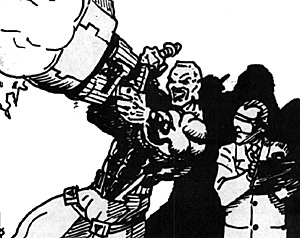 Draco Starkiller, mercenary extraordinaire,
sat in his friend's warehouse laboratory and eyed
the odd-looking contraption in his hands with a
great deal of suspicion. He gave its inventor a
similar look.
Draco Starkiller, mercenary extraordinaire,
sat in his friend's warehouse laboratory and eyed
the odd-looking contraption in his hands with a
great deal of suspicion. He gave its inventor a
similar look.
"I still don't get it, Wingnut. What's it do again?"
The goggle-eyed, primly-dressed man sighed heavily, something he seemed to do a lot whenever Draco was nearby.
"Like I explained twice before, Draco, it's a Gluon Disassociator. It projects a field that suppresses the strong nuclear force that holds atomic nuclei together."
Draco stared at him blankly.
Wingnut sighed again. "Anything you shoot it at goes boom."
When the inventor at last saw the light dawn in Draco's eyes, he continued. "It works pretty well under laboratory conditions, but it has yet to be field-tested. Since you seem to - ahem - get into combat situations a lot, I thought you might want to try it out for me." "Hmph. Guess so." Draco hefted the strange, heavy rifle in his hands and idly pointed it at an empty table. "So you just aim and shoot it like any other gun?" His finger began to squeeze the trigger.
Wingnut leaped out of his chair, grabbing wildly for the Gluon Disassociator. "No!" he screamed, "don't do that without - ! "
Draco never heard Wingnut, because the building around them shattered with a deafening roar. He had one last thought just as the walls exploded and hideous, painful darkness engulfed him.
"Cool!"
Fusion guns. Galaxy,spanning starships. Intelligent computers. Huge, death-dealing robots.
Big deal.
There comes a time in every science-fiction campaign when the standard technology in the game becomes mundane, when the neat devices that once so enthralled your players become just so many can openers.
To remedy this, referees may want to introduce something new and different that will keep the sense of technological wonder in the campaign alive. But what should it be? How should one go about introducing it into the campaign? What ramifications will such new technology have on the ongoing game?
Basic Principles
Before we address any specifics of new tech, several factors that must be taken into consideration first.
Repercussions:
First and foremost, you must realize that any innovations you introduce will have long-range effects on your game world. In most cases these will be minor (a new class of laser rifle may just displace older models, for instance), but in others the effects can be radical to both society and game balance (cheap and readily available teleportation could cause the crime rate to rocket out of control). Always think through the long-terrn effects of new tech.
Plausibility:
In order to maintain the verisimilitude of the game's technology, the referee should determine early on exactly what is and is not pos. sible in his game universe.
In other words, the referee should set up general parameters for each major field of science and stick to them when introducing new tech. These limits will vary from referee to referee, depending on his plans for the campaign, and from game to game, depending on its style. Hard science games, like Traveller and Albedo, should stick to realworld science or widely-accepted theories.
Soft science games like Star Trek and Star Wars have more leeway, but even these must adhere to their established conventions, Death Stars shouldn't be tooling around the Federation, nor should Luke and Han be beaming down to Tatooine anytime soon.
Compatibility:
The referee should also take into account the style of his science-fiction campaign, so that the innovations introduced won't spoil the flavor of the game. Anti-gravity might logically follow the technological progression of the Battletech universe, but Traveller-style grav tanks would quickly make battlemechs, the focus of the game, obsolete. The force fields from Star Trek may be cool, but they have no place in an ultra-gritty, hard-science setting like Cyberpunk 2.0.2.0.
Acceptance:
The disposition of your campaign's societies will determine what sort of innovations will be easier to introduce than others. In the Traveller universe, for example, AI robots are very rare and greatly mistrusted, and any new advances in robotics will meet with open hostility by the populace, Thus any new research into this field will be greatly stifled.
In Star Wars, however, Al robots (Droids) are all over the place, and new lines of robots are openly sought after. Robotics in this universe will be a very fertile field for new technology.
Proportion:
Don't go innovation happy. Keep the pace of technological progress to a level that both you and your players can easily assimilate. Introduce new technology only when the old innovations start to lose their luster, or when some new device makes for an interesting plot point or adventure hook.
New and Improved Going Beyond Your Game's Given Technology
Back to Shadis #28 Table of Contents
Back to Shadis List of Issues
Back to MagWeb Master List of Magazines
© Copyright 1996 by Alderac Entertainment Group
This article appears in MagWeb (Magazine Web) on the Internet World Wide Web.
Other military history articles and gaming articles are available at http://www.magweb.com